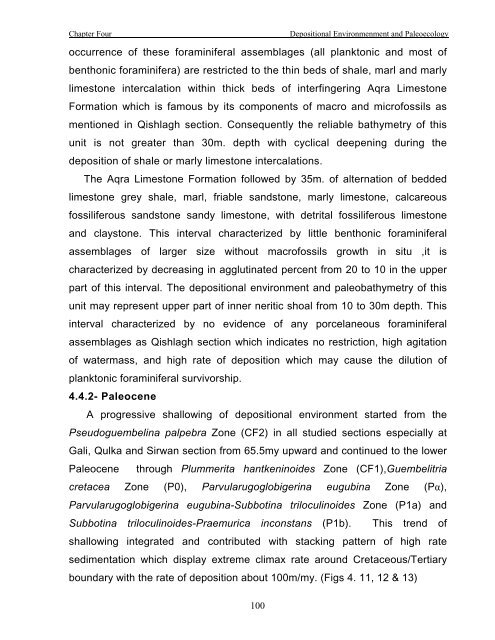biostratigraphy and paleoecology of cretaceous/tertiary boundary in ...
biostratigraphy and paleoecology of cretaceous/tertiary boundary in ...
biostratigraphy and paleoecology of cretaceous/tertiary boundary in ...
You also want an ePaper? Increase the reach of your titles
YUMPU automatically turns print PDFs into web optimized ePapers that Google loves.
Chapter Four<br />
Depositional Environmenment <strong>and</strong> Paleoecology<br />
occurrence <strong>of</strong> these foram<strong>in</strong>iferal assemblages (all planktonic <strong>and</strong> most <strong>of</strong><br />
benthonic foram<strong>in</strong>ifera) are restricted to the th<strong>in</strong> beds <strong>of</strong> shale, marl <strong>and</strong> marly<br />
limestone <strong>in</strong>tercalation with<strong>in</strong> thick beds <strong>of</strong> <strong>in</strong>terf<strong>in</strong>ger<strong>in</strong>g Aqra Limestone<br />
Formation which is famous by its components <strong>of</strong> macro <strong>and</strong> micr<strong>of</strong>ossils as<br />
mentioned <strong>in</strong> Qishlagh section. Consequently the reliable bathymetry <strong>of</strong> this<br />
unit is not greater than 30m. depth with cyclical deepen<strong>in</strong>g dur<strong>in</strong>g the<br />
deposition <strong>of</strong> shale or marly limestone <strong>in</strong>tercalations.<br />
The Aqra Limestone Formation followed by 35m. <strong>of</strong> alternation <strong>of</strong> bedded<br />
limestone grey shale, marl, friable s<strong>and</strong>stone, marly limestone, calcareous<br />
fossiliferous s<strong>and</strong>stone s<strong>and</strong>y limestone, with detrital fossiliferous limestone<br />
<strong>and</strong> claystone. This <strong>in</strong>terval characterized by little benthonic foram<strong>in</strong>iferal<br />
assemblages <strong>of</strong> larger size without macr<strong>of</strong>ossils growth <strong>in</strong> situ ,it is<br />
characterized by decreas<strong>in</strong>g <strong>in</strong> agglut<strong>in</strong>ated percent from 20 to 10 <strong>in</strong> the upper<br />
part <strong>of</strong> this <strong>in</strong>terval. The depositional environment <strong>and</strong> paleobathymetry <strong>of</strong> this<br />
unit may represent upper part <strong>of</strong> <strong>in</strong>ner neritic shoal from 10 to 30m depth. This<br />
<strong>in</strong>terval characterized by no evidence <strong>of</strong> any porcelaneous foram<strong>in</strong>iferal<br />
assemblages as Qishlagh section which <strong>in</strong>dicates no restriction, high agitation<br />
<strong>of</strong> watermass, <strong>and</strong> high rate <strong>of</strong> deposition which may cause the dilution <strong>of</strong><br />
planktonic foram<strong>in</strong>iferal survivorship.<br />
4.4.2- Paleocene<br />
A progressive shallow<strong>in</strong>g <strong>of</strong> depositional environment started from the<br />
Pseudoguembel<strong>in</strong>a palpebra Zone (CF2) <strong>in</strong> all studied sections especially at<br />
Gali, Qulka <strong>and</strong> Sirwan section from 65.5my upward <strong>and</strong> cont<strong>in</strong>ued to the lower<br />
Paleocene through Plummerita hantken<strong>in</strong>oides Zone (CF1),Guembelitria<br />
cretacea Zone (P0), Parvularugoglobiger<strong>in</strong>a eugub<strong>in</strong>a Zone (Pá),<br />
Parvularugoglobiger<strong>in</strong>a eugub<strong>in</strong>a-Subbot<strong>in</strong>a trilocul<strong>in</strong>oides Zone (P1a) <strong>and</strong><br />
Subbot<strong>in</strong>a trilocul<strong>in</strong>oides-Praemurica <strong>in</strong>constans (P1b). This trend <strong>of</strong><br />
shallow<strong>in</strong>g <strong>in</strong>tegrated <strong>and</strong> contributed with stack<strong>in</strong>g pattern <strong>of</strong> high rate<br />
sedimentation which display extreme climax rate around Cretaceous/Tertiary<br />
<strong>boundary</strong> with the rate <strong>of</strong> deposition about 100m/my. (Figs 4. 11, 12 & 13)<br />
100

















